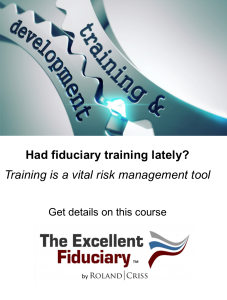Tip for October 2016

The U.S. Department of Labor’s (“DOL”) change in the definition of an investment fiduciary has ushered in a dramatic shift in risk management focus for chief financial officers and human resource executives. This article explores how the “old school” way of interacting with investment advice providers has been jolted by a new imperative.
Juggling the Risks
C-suite executives face compliance responsibilities under several major regulatory programs and their enforcement agencies. The cause and effect on an organization’s business risk is not equal among all regulatory programs.
Consequently, it is not surprising that a hierarchy of focus has developed among many organizations over the years that effectively ranks regulatory programs according to their perceived impact on the organization’s risk exposure.
Reshuffling Priorities
Studies conducted by the DOL strongly suggest that a focus on ERISA fiduciary behavior among organizations sponsoring retirement plans is a lower priority than most other regulatory programs. With its Conflict of Interest Rule effective in 2017, however, the DOL is forcing executives that oversee their organization’s employee benefit plans to change quickly both their thinking and their behavior.
The rule requires those who provide investment advice to acknowledge their status as “fiduciaries,” but places the burden on plan sponsors to verify their investment advisors’ conduct. The old school fiduciary approach generally disregarded service providers’ conflicts of interest. There was no pressure for a retirement plan’s investment advisors to prove their experience, credentials, or objectivity in investment recommendations.
Where there’s Smoke, there’s Fire
The Conflict of Interest rule was put into place to bring more awareness to plan sponsors about the risks involved when engaging third party providers to advise on investing retirement plan assets. So how do ERISA plan sponsor executives effectively navigate the transition to this new school of fiduciary behavior?
The answer is not mysterious, nor is the solution foreign to CFOs and other risk managers. Just as corporations and nonprofits such as hospitals, colleges, and universities annually test their financial controls, the Testing of Practices has emerged as the starting point for navigating this transition.
Tips:
In the new school of fiduciary duty, the measurement of vendors’ practices and progress against a written standard of objectives and steps is critical. The Testing of Practices combines measuring not only what is done (performance) but also how it is accomplished (behavior).
“New school” fiduciary leaders combine this key principle of stewardship with practical risk management tactics that safeguard their plan participants’ assets. This means aligning with best-practice standards of fiduciary care.
For those leaders dedicated to high performance across all areas of their organization, keeping the following questions in mind will help keep them on the newly defined path toward fiduciary excellence:
- What specific steps comprise ERISA’s fiduciary requirements?
- What are our ERISA plan risk assessment standards?
- How do our policies align with our actual fiduciary behaviors?
- Do our partners have conflicts of interest that may negatively impact our organization or its employees?
- How do we measure our performance as a fiduciary committee and how do we measure that of our providers?




